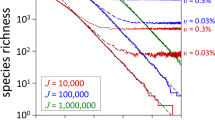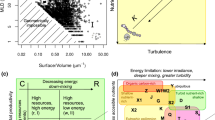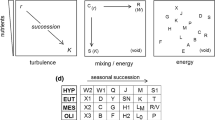Abstract
An exercise in which experienced phycologists were invited to nominate (`design') the phytoplankton of a lake, given a description of the physical and chemical conditions, is reported. Few intuitively reversed the process by which they might judge the source of a given unattributed sample on the basis of the algal assemblage. It is argued that the power of preferential selection of particular adaptations of phytoplankton can be invoked predictively through resort to functional groups (`associations').
Similar content being viewed by others
References
Alvarez Cobelas, M., C. S. Reynolds, P. Sanchez-Castillo & J. Kristiansen, 1998. Phytoplankton and trophic gradients. Hydrobiologia 369/370 (Dev. Hydrobiol. 129): 1–2.
Belcher, J. H., 1968. Notes on the physiology of Botryococcus braunii Kützing. Arch. Mikrobiol. 61: 335–346.
Berman, T., Y. Z. Yacobi & U. Pollingher, 1992. Lake Kinneret phytoplankton: stability and variability during 20 years (1970-1989). Aquat. Sci. 54: 104–127.
Hambright, K. D., M. Gophen & S. Serruya, 1994. Influence of long-term climatic changes on the stratification of a subtropical, warm monomictic lake. Limnol. Oceanogr. 39: 1233–1242.
Lewis, W. M., 1978. Analysis of succession in a tropical phytoplankton community. Am. Nat. 112: 401–414.
Lind, E. M., 1944. The phytoplankton of some Cheshire meres. Mem. Proc. Manchester lit. phil. Soc. 90: 1–20.
Malinsky-Rushansky, N., T. Berman & Z. Dubinsky, 1995. Seasonal dynamics of picophytoplanktonin Lake Kinneret, Israel. Freshwat. Biol. 34: 241–255.
Olrik, K., 1994. Phytoplankton ecology. Miljøministeriet, København: 162 pp.
Olrik, K., 1997. Danmarks planteplankton. Gads Forlag, København: 124 pp.
Padisák, J. & C. S. Reynolds, 1998. Selection of phytoplankton associations in Lake Balaton, Hungary, in response to eutrophication and restoration measures, with special reference to the cyanoprokaryotes. Hydrobiologia 384: 41–53.
Rawson, D. S., 1956. Algal indicators of trophic lake types. Limnol. Oceanogr. 1: 18–25.
Reynolds, C. S., 1997. Vegetation processes in the pelagic: a model for ecosystem theory. Ecology Institute, Oldendorf: 371 pp.
Reynolds, C. S., 1998a. The state of freshwater ecology. Freshwat. Biol. 39: 741–753.
Reynolds, C. S., 1998b. What factors influence the species composition of phytoplankton in lakes of different trophic status? Hydrobiolgia 369/370 (Dev. Hydrobiol. 129): 11–26.
Reynolds, C. S. & S. E. Allen, 1968. Changes in the phytoplankton of Oak Mere following the introduction of base-rich water. Br. phycol. Bull. 3: 451–462.
Reynolds, C. S. & E. D. Bellinger, 1992. Patterns of abundance and dominance of the phytoplankton of Rostherne Mere, England: evidence from an 18-year data set. Aquat. Sci. 54: 10–36.
Rodhe, W., 1948. Environmental requirements of freshwater plankton algae: experimental studies in the ecology of phytoplankton. Symb. bot. Upsal. 10: 5–149.
Swale, E. M. F., 1968. The phytoplankton of Oak Mere, Cheshire, 1963-1966. Br. phycol. Bull. 3: 441–449.
Vollenweider, R. A. & J. Kerekes, 1980. The loading concept as basis for controlling eutrophication philosophy and preliminary results of the OECD programme on eutrophication. Progress inwater Technology 12 (2): 5–38.
Author information
Authors and Affiliations
Rights and permissions
About this article
Cite this article
Reynolds, C.S. Phytoplankton designer – or how to predict compositional responses to trophic-state change. Hydrobiologia 424, 123–132 (2000). https://doi.org/10.1023/A:1003913330889
Issue Date:
DOI: https://doi.org/10.1023/A:1003913330889




